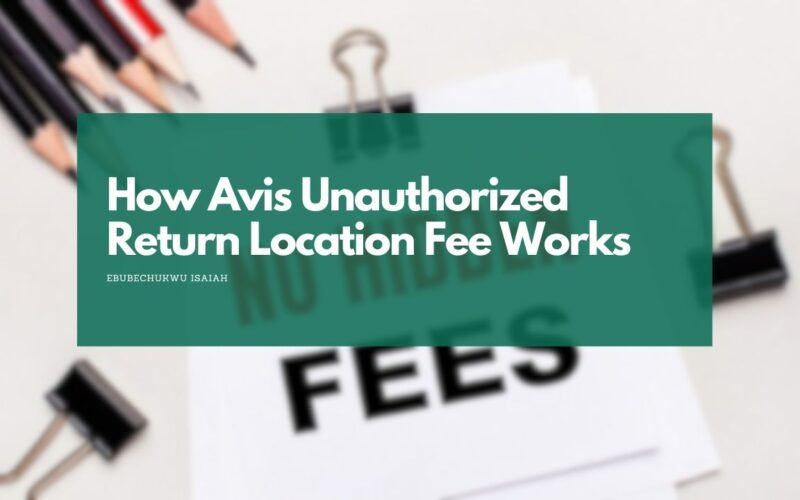As an Amazon Associate, I earn a small commission from qualifying purchases. Learn more about this.
Renting a car can be a seamless experience, but what happens when your plans change and you need to return your vehicle to a location different from where you picked it up?
Avis, like many rental companies, has a set of policies in place for such scenarios.
In this article, we’ll take a look at this properly as well as the unauthorized return location fee (the fee Avis imposes).
Why does the Unauthorized Return Location Fee exist?
When you rent a car, the rental agreement outlines the return location, typically the same place where you picked up the vehicle.
This arrangement helps the rental company manage their fleet effectively, ensuring that cars are available where and when they’re needed by other customers.
However, there may be instances where, for whatever reason, you might find it more convenient or necessary to return the vehicle to a different location.
While this might solve a problem for you, it creates a ripple effect of challenges for the rental company.
They might now have an oversupply of vehicles in one location and a shortage in another, which could disappoint other customers and require additional resources to rectify.
The Unauthorized Return Location Fee is thus a deterrent, encouraging customers to adhere to the agreed return location and a way to cover the costs that come with relocating the vehicle.
These costs could include transporting the vehicle back to its original location, additional staffing, and the potential lost revenue from having the vehicle unavailable for other customers.
Furthermore, having a clear return location helps Avis maintain a streamlined operation, allowing them to offer competitive rental rates and ensure customer satisfaction by having vehicles available where they’re needed most.
How much is the Avis Unauthorised Return Location Fee?
The exact amount of the Unauthorized Return Location Fee can vary. Factors influencing the fee include:
- Distance from the original drop-off location: Naturally, if the distance between the agreed drop-off location and the unauthorized return location is vast, the fee might be higher.
- Demand at the unauthorized return location: If the unauthorized location is in high demand for vehicles, the fee might be less, as the returned car could be quickly rented out again.
- Duration of rental: If you’ve rented the car for an extended period, there might be some leniency in fees, but this isn’t always the case.
- Specific location regulations: Some locations, especially those in airports or city centers, might have higher fees due to space constraints or local regulations.
Always consult your rental agreement or speak directly with Avis representatives to get precise details.
The Right Procedure When Returning a rental to a different location
Life is full of unexpected twists and turns, and there may come a situation where returning the rental car to the original location might not be feasible or convenient.
In such scenarios, it’s essential to follow the correct procedure to avoid any unnecessary fees, like the Unauthorized Return Location Fee we discussed earlier.
Firstly, communication is key. If you find yourself needing to return the car to a different location, it’s imperative to contact the rental company as soon as possible.
Informing them ahead of time will not only help in avoiding any unauthorized fees but also assist the company in making necessary adjustments to their fleet management.
A quick call to Avis or dropping by one of their branches to discuss the change can save you a lot of trouble and extra charges.
Now, if the change in the return location is approved, it’s time to get acquainted with the new return procedure.
Each rental location might have its own set of rules when it comes to returning a car.
Make sure to ask for detailed instructions regarding where and how to return the car, the working hours of the return location, and any other pertinent information. It’s always better to have clear instructions than to face uncertainties later on.
Moreover, it’s advisable to document the condition of the car before returning it.

Take pictures or videos of the interior and exterior of the car, focusing on the mileage, fuel level, and any existing damages.
This documentation will serve as proof of the car’s condition upon return, which can be handy in case of disputes.
Furthermore, ensure that the car is clean and the fuel tank is filled as per the rental agreement. Most rental companies require the car to be returned with a full tank, or they’ll charge a refueling fee which can be quite pricey.
Also, if you’ve opted for a different return location, check if there are any additional requirements or fees for doing so.
It’s also wise to keep a copy of the updated rental agreement, the approval for the change in return location, and any other related paperwork.
Having a well-documented trail of communication and approvals will provide a clear reference in case there are questions or issues later on.
Lastly, make it a point to return the car during the working hours of the return location. If that’s not possible, inquire about the procedure for after-hours returns. Different locations might have different policies, and it’s crucial to adhere to them to avoid any additional charges.
Conclusion
Flexibility is often a must when traveling, but it’s always beneficial to understand the costs associated with changes to plans, especially when renting a vehicle. The Unauthorized Return Location Fee, while initially seeming like just another pesky charge, has valid reasons behind its imposition.







